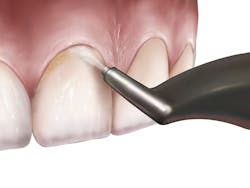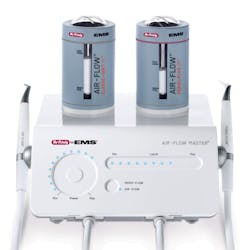Sponsored article
Traditionally, dental professionals have been taught to treat biofilm with hand scaling and power instruments—two time-consuming methods that just aren’t as effective as they should be on biofilm. Air polishing is another option, but one that most tend to avoid because of its old reputation as a messy, uncomfortable treatment that is focused on supragingival procedures and stain removal. Hu-Friedy is changing that perception with AIRFLOW® Therapy.
AIRFLOW isn’t a typical air polishing system. It gives hygienists, clinicians, and specialists a more efficient tool for recall appointments as well as for more advanced perio and specialty cases. Incorporating AIRFLOW Therapy reduces the amount of time it takes to treat biofilm, making practices more efficient and profitable, while most importantly allowing clinicians to provide patients with optimal care.
Unlike the air polishing devices dental professionals are used to, AIRFLOW Therapy is an advanced biofilm management system that works on every patient. It’s equipped to reach and remove biofilm on the most difficult and delicate surfaces where rubber cups have limited access, or where hand and power scaling would take too long. This includes crowded teeth, periodontal pockets, implants, and ortho brackets.
AIRFLOW Therapy is designed for procedures and clinical situations that typical air polishing systems simply can’t handle. When used before scaling, the process becomes easier and takes less time to complete. AIRFLOW’s versatility makes it the perfect enhancement to hygiene procedures, elevating these appointments both clinically and practically.
The clinical benefits
Biofilm can be removed in five ways:
- Hand scaling
- Ultrasonic scaling
- Rubber cup polishing (paste polishing)
- Air polishing
- Flossing
Most dental professionals rely on the first three on the list, with 44% of clinicians using ultrasonic scaling for supragingival biofilm removal and 76% of clinicians turning to ultrasonic scaling for subgingival biofilm removal.*
AIRFLOW Therapy can be more efficient and effective than ultrasonic scaling and any other method. The leading products in this category, typically focused on supragingival procedures and stain removal, are known for being messy, gritty, and even painful for patients. That’s not the case with AIRFLOW Therapy, which is changing the industry mindset and doing away with these preconceptions.
Not only does AIRFLOW address both biofilm and stain removal, it’s comfortable for patients and effective on all surfaces up to 5 mm deep. Patients have a more pleasant experience and leave the office with teeth that feel smooth and clean. So, what makes AIRFLOW different from traditional air polishing systems? The powders offer a more comfortable and more versatile treatment option compared to sodium bicarbonate powders.
AIRFLOW’s new PLUS Powder is made with erythritol, a sugar alcohol with a grain size of just 14 microns. It’s ideal for supra and subgingival biofilm disruption and light to moderate stain removal, and safe on almost all tooth surfaces. It removes biofilm gently and effectively expands the reach of air polishing far beyond what most clinicians have experienced, opening up a new alternative that enhances patient care.
Also, for light to moderate stain removal, AIRFLOW Perio Powder uses glycine, a low abrasive amino acid that is safe on almost all surfaces. This fine-grain powder is ideal for subgingival use and aiding in disease prevention for periodontitis, mucositis, and peri-implantitis. At only 25 microns, Perio Powder provides a gentle patient experience.
Sodium Bicarbonate’s grain structure and size make it better suited for heavy stain removal, with powders ranging from 60 to 120 microns. Those features also make it harsh. To compare, AIRFLOW Classic Comfort Powder features a grain size of 40 microns, further increasing patient comfort without sacrificing stain removal.
Incorporating AIRFLOW Therapy
- Screening/exam diagnosis
- AIRFLOW Therapy for biofilm removal
- Scaling for calculus removal
- Patient education and extra services
Why is biofilm removal second on the list? Completing this step at the beginning of the appointment maximizes its benefits for dental professional and patients. Here’s how:
Biofilm is out of the way. Hygienists no longer have to perform “stroke by stroke” removal of biofilm, which is pretty labor intensive. AIRFLOW does most of the heavy lifting, meaning biofilm is taken care of before the hygienist even picks up any power instruments or scalers.
Calculus becomes easier to detect. Removing biofilm provides a clean slate to work with. There’s nothing hindering hygienists from seeing or feeling hard deposits.
It saves time. When dental professionals incorporate AIRFLOW Therapy into their practices, biofilm removal doesn’t take nearly as long as it does with traditional methods. Since the biofilm is already gone, scaling efforts can focus on hard deposit detection and removal, and rubber cup polishing is eliminated. This, of course, leads to happier patients who stay loyal and refer family and friends, while also giving dental professionals more time to spend on other practice-building tasks throughout the day.
The practical ways AIRFLOW Therapy can help a practice
One of the biggest advantages AIRFLOW Therapy gives a practice is more time. Using instruments for biofilm removal typically takes 30 to 64 seconds per tooth. That drops to 5 seconds per tooth with AIRFLOW for an average of eight to 12 minutes per appointment.
The time AIRFLOW Therapy gives dentists back is invaluable, and can be used to improve practices in a variety of ways. Hygienists can spend the extra minutes in each appointment talking with patients about other services the practice offers that meet their dental health goals, such as clear aligners, whitening, fluoride varnish and sealants. These conversations help grow practices and boost revenues. Hygienists also find they have more time to complete perio charting and critical screenings.
After adding AIRFLOW Therapy to their tool box, it’s important for dentists and hygienists to educate patients about the leading-edge device. They should talk with them about how it will make their experience more comfortable, while also reducing the time they spend in the chair. Patients will appreciate the more efficient appointments and the commitment the practice has made to providing optimal patient care. They’ll be happier and more likely to stay loyal—as well as sing the practice’s praises to family and friends.
There is a better way
It’s time for dental professionals to shift their mindset about air polishing. The messy, uncomfortable legacy products no longer define this category. AIRFLOW Therapy is changing how dental professionals look at air polishing and proving there’s a better way. This system offers a more efficient way to remove biofilm and improve the patient experience, upgrading dental hygiene protocols and eliminating the drawbacks that come with traditional air polishing products.
See the difference with AIRFLOW for yourself by requesting a free in-office demo.
*Hu-Friedy data on file.



